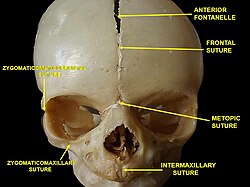Metopism

Editor-In-Chief: Prab R Tumpati, MD
Obesity, Sleep & Internal medicine
Founder, WikiMD Wellnesspedia &
W8MD medical weight loss NYC and sleep center NYC
| Metopism | |
|---|---|

| |
| Synonyms | Persistent metopic suture |
| Pronounce | N/A |
| Specialty | N/A |
| Symptoms | Presence of a suture line on the frontal bone |
| Complications | None |
| Onset | Birth |
| Duration | Lifelong |
| Types | N/A |
| Causes | Genetic factors, developmental variation |
| Risks | None |
| Diagnosis | Radiography, CT scan |
| Differential diagnosis | Craniosynostosis |
| Prevention | N/A |
| Treatment | None required |
| Medication | N/A |
| Prognosis | Excellent |
| Frequency | Varies by population |
| Deaths | N/A |

Metopism refers to the persistence of the metopic suture, also known as the frontal suture, in the forehead beyond early childhood. Normally, this suture, which runs down the midline of the skull from the top of the head down the forehead to the nose, fuses between the ages of 3 to 9 years. When this suture does not fuse and remains visible in adulthood, the condition is termed metopism.
Introduction[edit]
The human skull is made up of several plates of bone that are separated by sutures at birth. These sutures allow for growth of the skull and the brain during infancy and childhood. One of these, the metopic suture, divides the frontal bone into two halves. In most individuals, this suture closes in early childhood, but in some cases, it remains open or partially open, a condition known as metopism.
Epidemiology[edit]
Metopism is relatively rare, with its prevalence varying among different populations. It is more commonly observed in males than in females. The exact reasons for the variation in the rate of closure of the metopic suture are not fully understood but are thought to involve genetic and environmental factors.
Clinical Significance[edit]
In most cases, metopism is simply a normal anatomical variant with no clinical significance. However, in some instances, it can be associated with certain craniofacial syndromes or abnormalities. Therefore, if metopism is observed, especially if it is pronounced or accompanied by other cranial anomalies, further evaluation may be warranted to rule out underlying conditions.
Diagnosis[edit]
Diagnosis of metopism is primarily based on physical examination and imaging studies such as X-rays or CT scans. These imaging techniques can help to visualize the extent of suture patency and identify any associated cranial abnormalities.
Treatment[edit]
For the majority of individuals with metopism, no treatment is necessary. In cases where metopism is associated with craniofacial syndromes or other abnormalities, treatment may be directed towards the underlying condition.
Summary[edit]
Metopism is a rare condition characterized by the non-fusion of the metopic suture. While it is usually of no clinical significance, its presence can sometimes indicate underlying cranial abnormalities. As such, individuals with pronounced metopism should undergo further evaluation to ensure there are no associated conditions.
Ad. Transform your life with W8MD's Budget GLP-1 injections from $75


W8MD offers a medical weight loss program to lose weight in Philadelphia. Our physician-supervised medical weight loss provides:
- Weight loss injections in NYC (generic and brand names):
- Zepbound / Mounjaro, Wegovy / Ozempic, Saxenda
- Most insurances accepted or discounted self-pay rates. We will obtain insurance prior authorizations if needed.
- Generic GLP1 weight loss injections from $75 for the starting dose.
- Also offer prescription weight loss medications including Phentermine, Qsymia, Diethylpropion, Contrave etc.
NYC weight loss doctor appointmentsNYC weight loss doctor appointments
Start your NYC weight loss journey today at our NYC medical weight loss and Philadelphia medical weight loss clinics.
- Call 718-946-5500 to lose weight in NYC or for medical weight loss in Philadelphia 215-676-2334.
- Tags:NYC medical weight loss, Philadelphia lose weight Zepbound NYC, Budget GLP1 weight loss injections, Wegovy Philadelphia, Wegovy NYC, Philadelphia medical weight loss, Brookly weight loss and Wegovy NYC
|
WikiMD's Wellness Encyclopedia |
| Let Food Be Thy Medicine Medicine Thy Food - Hippocrates |
Medical Disclaimer: WikiMD is not a substitute for professional medical advice. The information on WikiMD is provided as an information resource only, may be incorrect, outdated or misleading, and is not to be used or relied on for any diagnostic or treatment purposes. Please consult your health care provider before making any healthcare decisions or for guidance about a specific medical condition. WikiMD expressly disclaims responsibility, and shall have no liability, for any damages, loss, injury, or liability whatsoever suffered as a result of your reliance on the information contained in this site. By visiting this site you agree to the foregoing terms and conditions, which may from time to time be changed or supplemented by WikiMD. If you do not agree to the foregoing terms and conditions, you should not enter or use this site. See full disclaimer.
Credits:Most images are courtesy of Wikimedia commons, and templates, categories Wikipedia, licensed under CC BY SA or similar.
Translate this page: - East Asian
中文,
日本,
한국어,
South Asian
हिन्दी,
தமிழ்,
తెలుగు,
Urdu,
ಕನ್ನಡ,
Southeast Asian
Indonesian,
Vietnamese,
Thai,
မြန်မာဘာသာ,
বাংলা
European
español,
Deutsch,
français,
Greek,
português do Brasil,
polski,
română,
русский,
Nederlands,
norsk,
svenska,
suomi,
Italian
Middle Eastern & African
عربى,
Turkish,
Persian,
Hebrew,
Afrikaans,
isiZulu,
Kiswahili,
Other
Bulgarian,
Hungarian,
Czech,
Swedish,
മലയാളം,
मराठी,
ਪੰਜਾਬੀ,
ગુજરાતી,
Portuguese,
Ukrainian
